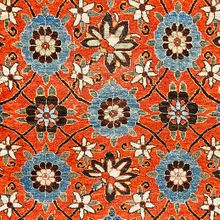Varamin Rug
| Varamin Rug | |
|---|---|
 Design of Varamin Rug (Rugman) | |
| General information | |
| Name | Varamin Rug |
| Original name | قالي ورامین |
| Alternative name(s) | Varamin Carpet |
| Origin | |
| Category | Village |
| Technical information | |
| Common designs | Vagireh, Afshan |
| Common colors | Blue, Navy Blue, Cream, Red, Beige, Green |
| Dyeing method | Natural, Synthetic |
| Pile material | Wool |
| Foundation material | Cotton |
| Knot type | Asyemmetrical (Persian), Symmetrical (Turkish) |
History
Varamin, also spelled Veramin in the trade, is a city in the Tehran Province of north central Iran. Varamin rugs are categorized in the trade under two time periods, the last quarter of the nineteenth century and 1920s to the present day.[1]
Materials
Foundation and Pile
The rugs have wool foundation and a wool pile.[2]
Techniques and structures
Color and dyeing
Early Varamin rugs have deep red or dark blue coloration for the background. These colors are interchangeable for the borders.[3]
Motifs and patterns
Weaving techniques
The Turkish (symmetric) knot is employed.[4]
See also
References
Bibliography
Abraham Levi Moheban, (2015), The Encyclopedia of Antique Carpets: Twenty-Five Centuries of Weaving, NewYork: Princeton Architectural Press.